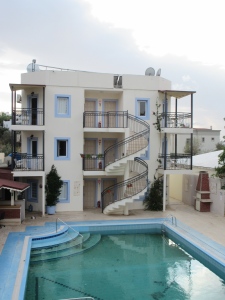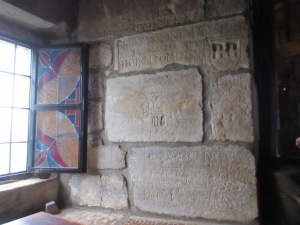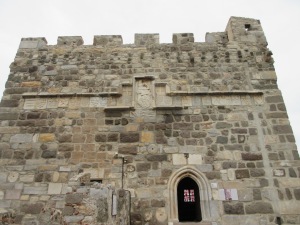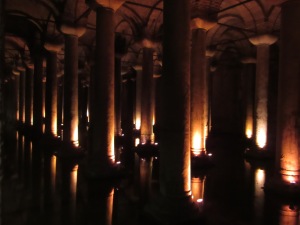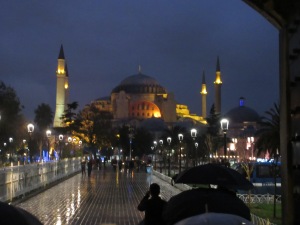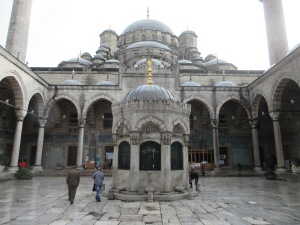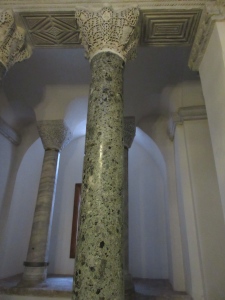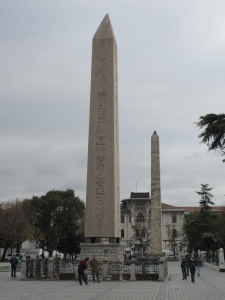We’ve spent the last couple weeks down in the SW corner of Turkey in a place called Bodrum. Bodrum was previously known as the ancient Greek city of Halicarnassus. Like much of the Aegean and Mediterranean Turkish coast, the area has a long history. Recorded settlements at this location date back 3000 years with signs of people living more simply before then. Roman and Medieval ruins are visible around town. They are built on top of and out of Hellinistic ruins. For example, when King Mausolus died his sister/wife built a tremendous burial monument to him here. It was one of the seven wonders of the ancient world and known as the Mausoleum (the source of the word we know today). After an earthquake damaged it centuries later, Crusaders used the stones to build a medieval fortress that today houses a superb museum.

What is left of the Mausoleum today. The large rock in the center was installed as a plug to Mausolus’s tomb, which was deep under the monument.
Modern day Bodrum has been a tourist destination for decades. The protected harbor has hundreds of yachts, many the traditional gulet. The hills are covered with sugar-cube white houses and olive trees. In the summer this place is packed. The Bodrum Peninsula extends to the west with a handful of smaller towns, beaches, bays, and hills. Now is decidedly the off-season and many things are closed up. The restaurants that stay open struggle to keep their best staff on payroll through the winter and offer some excellent lunch deals. We’ve spent our days exploring town and the peninsula. It must be a very different place in the summer with exponentially more people.
Our biggest struggle here has been traffic. Our guide books discouraged us from driving in Turkey, explaining that it has a very high accident rate. Walking around town often feels dangerous. Clearly, we are westerners who are used to a different set of rules. I am outraged every time that a car or truck parks on the sidewalk, pushing pedestrians out into busy streets. Scooters drive on the road, on the sidewalk, in the alleys, and everywhere else. At times it feels like they have agreed to pass pedestrians with no more than five inches of clearance. Personal safety seems to not be a priority, which makes our favorite pastime, walking, a lot less pleasant. On the flip side, there is an excellent minibus system. We can get to anywhere on the peninsula for about $2. The minibuses run on a schedule, are clean and organized, and go every 15-45 minutes from early in the morning to past our bedtime.
There are a handful of things that make Turkey unique from our recent travels:
-Olives, honey, and tea are ubiquitous. Even the little minimart will have multiple types of honey and tea leaves in bags bigger than a loaf of bread.
-Stray cats and dogs run the streets. It seems that many people are willing to feed them as few are scrawny. Large water and food bowls are not uncommon. Other than wanting a scratch or accepting food, they are generally not too interested in people.
-The body language for yes and no is different: a nod down means ‘yes,’ a nod up means ’no,’ and shaking your head means ‘I don’t understand.’ Fortunately for us, they are pretty used to foreigners but we’ve had some hilarious misunderstandings at the market as we attempt to specify how many kilos of mandarins or dried figs we want.
-99.9% of the country is Muslim. The call to prayer echoes off the hillsides five times a day. Men are seen socializing in public more often than women are.
-Mandarins are in peak season and we’ve taken to eating them by the kilo as they are so delicious and really cheap. Many of the landscaping trees in town are citrus so it is not uncommon to see a passerby picking what they can reach.
-Public nationalism is strong. Large flags and images of Ataturk (the father of Turkey) hang everywhere. Historical plaques paint a rosy picture of Turkish strength. It is illegal to speak poorly of the Turkish government.
-The cafe scene here is even stronger than in Paris or Split. Each town has a cafe that is municipally owned where coffee and tea are very cheap and nearly every table is full all day long. Many have piles of board games for customers to use. Hordes of men wile away the afternoon with backgammon.
Stay tuned for the next post with some specific places and excursions. In the meantime, you can check out more pictures of Bodrum here and look at our map to see where Bodrum is.

Us gringos laughed at the idea of a “Second best hotel.” Turns out seçkin in Turkish means “outstanding.”

We were surprised how few old architecturally significant buildings there are in Bodrum, given the long history. It turns out earthquakes have demolished the city several times and unnoticeable small ones occur almost every day.

One of the original gates into Halicarnassus. When Alexander the Great attacked in 334 BC, a fierce battle ensued here. Note Megan standing in the entrance.

A Sunday afternoon soccer match between the local amateur team and a neighboring community. The stands were full and police lined up (in the far left) in case things got too exciting.

The Knights of St. John built the castle in Bodrum using stones from the then1700-year-old Mausoleum.
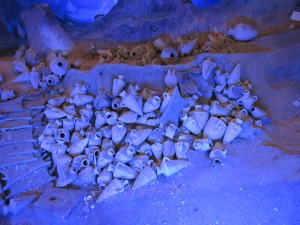
A ship wrecked in the 14th century BC leaving amphora and ingots of copper and tin. It took 22,000 dives over 11 years to excavate the site, recreated here in the superb Museum of Underwater Archaeology.





